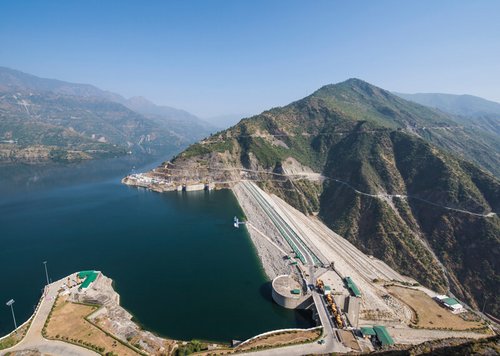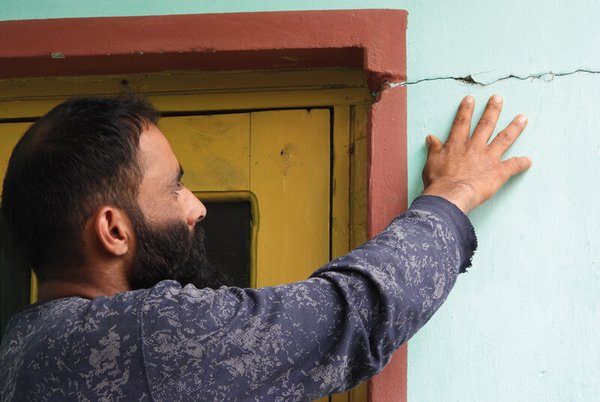 Download this article in magazine layout
Download this article in magazine layout
- Share this article
- Subscribe to our newsletter
Sinking houses in the Himalayas – hydropower projects to blame?
“We're going to pay a very heavy price for cutting down our forests and bulldozing our landscapes,” Ravi Chopra, a prominent environmental activist and scientist in the Himalayan state of Uttarakhand, told me during a conversation at his office in Dehradun last year in April. “It is so painful to see swathes of bare yellow earth dotted with road-building materials and construction workers on landscapes where thick forests stood until a few years ago,” he said. “It's driving us crazy.”
What Chopra was apprehensive of has finally started happening in Himalayan villages where not only railway tracks are being laid by blasting mountains and road widening is being carried out in sensitive landscapes but also a number of hydropower projects are being constructed, often without caring about the environmental consequences, according to environmental activists. Early in February 2022, the news agency Reuters reported that houses of villagers in places near construction areas had developed cracks and were at risk of facing total damage in several villages. “Nine residents from three villages along the 125 km rail route stretching from Rishikesh to Karnaprayag showed Reuters damage to their homes they said had started appearing soon after blasting or other work for 104 km of tunnels began near their villages,” the news agency stated.

The Tehri hydropower dam in Uttarakhand, India. Photo: Ravi – stock.adobe.com
What has brought the danger facing the homes of villagers in Himalayas into sharp focus is the sinking of over a hundred houses in Joshimath, a pilgrim township high in the Himalayas, in January of this year. Several houses have sunk, and many more have been declared unsafe with red marks even as thousands of residents have been evacuated from the town. Interestingly, only days after the sinking of houses in Uttarakhand was reported, hundreds of villagers had to be evacuated from Nai Basti, a village in another Himalayan region in India’s northern state of Jammu & Kashmir. “I had spent all my savings building that house. But then it has suddenly collapsed. I have no clue what can I do now,” said Tariq Ahmad, a villager whose house has suffered complete damage. “We had been living in this house for years. But, suddenly we lost it,” Shah Din, who works as a labourer, recalled, appealing to the government to help the villagers. The district administration had to evacuate 25 families. Din and several other families have been moved to makeshift housing while some families have been accommodated by their relatives and friends in their own homes.
The causes are obvious
In March 2020, residents of Dalwas, on the Srinagar-Jammu highway in Ramban district in the Kashmir Himalayas, had to flee their homes before the village was struck by landslides. The villagers blamed use of heavy machinery for the construction of the highway passing through their village. Experts say that they had repeatedly warned that haphazard construction amid new climate-driven vulnerabilities in the form of frequent extreme weather events and disasters was making the entire Himalayan region unsafe. In recent years, the Indian government has implemented dozens of hydropower construction projects and road construction projects leading to pilgrim sites high in the Himalayas.
Digging inside mountains with tunnel-boring machines, experts say, has not only multiplied the threats of land sinking and landslides, but has also disrupted the aquifers (groundwater sources), resulting in the drying up of Himalayan springs. As of today, said Sunita Narian, Director General of the New Delhi-based Centre for Science and Environment, some 7,000 megawatts (MW) of hydroelectric projects are either operating or being constructed in the fragile mountainous region of Uttarakhand with back-to-back dams and no respect for the river or its need to flow naturally. “The issue is not about the need for energy or development. It is about the carrying capacity of the fragile Himalayan region, which is even more at risk because of climate change”, she insisted.
“The era of hydropower dams is over”
“There is no question that we are going to see more of this, not less, unless we change the way we do business with the environment. But more importantly, it will happen until we take better studied decisions on the projects and on mitigating their impacts,” Narian said. “Our fragile mountains and the people living there are being put at risk for constructing these projects,” said Ravi Chopra, the environmentalist. He claimed that the blasting and digging operations were making the earth in the mountainous regions prone to subsidence and landslides. “In this time and age, hydropower makes no economic – and environmental – sense. For example, in Uttarakhand, to produce one unit of electricity, you need to spend seven to eight rupees for it. Now, tell me, who is going to buy it when solar power is produced at two-and-a-half rupees a unit?” Chopra noted. “The era of hydropower dams is over – in fact, it ended in the last century.”
After the devastating floods and landslides in Uttarakhand in June 2013, a Supreme Court-appointed committee which Chopra was part of had recommended that no dam should be built above an altitude of 2,000 metres. “But, despite that recommendation, infrastructure creation for those projects continued under one or the other pretext and one of those projects got damaged in the February 6 disaster – it was being built by a government company,” Chopra explained.
Sharachchandra Lele, of the Centre for Environment & Development at Ashoka Trust for Research in Ecology and the Environment (ATREE) said that the government definitely needed to rethink its development strategy for the Himalayas. “Climate change is aggravating environmental risks of the already environmentally fragile Indian Himalayan region. Damming of rivers, tunnelling for power generation, and indiscriminate road building are magnifying these risks and their impacts,” Lele claimed, insisting that indiscriminate building of dams had to stop.
When the issue of developmental projects in the environmentally sensitive Himalayan regions was recently raised in the country’s parliament, the Indian government didn’t comment about the details of construction activities in the Himalayas and what steps would be taken to stop the disasters in the Himalayas in future. It only told the parliament that the Himalayas were “unstable”, having a “dynamic geology” which “is leading to land subsidence”.
Athar Parvaiz is a freelance journalist based in Srinagar/ Kashmir, India.
Contact: atharparvaiz.ami(at)gmail.com





Add a comment
Be the First to Comment